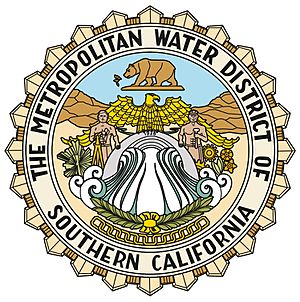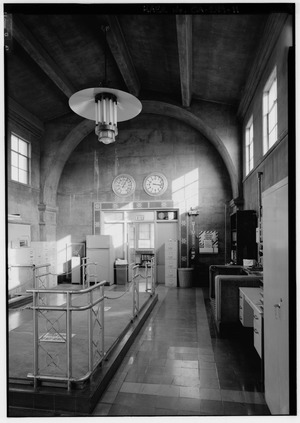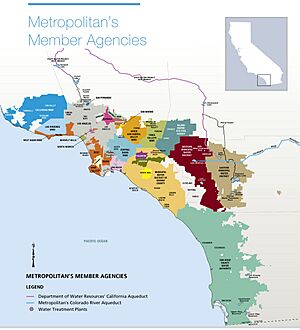Metropolitan Water District of Southern California facts for kids
 |
|
| Water district overview | |
|---|---|
| Formed | 1928 |
| Headquarters | 700 North Alameda Street, Los Angeles, California 34°3′17″N 118°14′11″W / 34.05472°N 118.23639°W |
| Water district executive |
|
The Metropolitan Water District of Southern California is a huge water supplier in the United States. It brings clean water to many homes and businesses. People often call it "Met," "Metropolitan," or "MWD" for short.
It's like a team of 14 cities and 12 water groups. They work together to give water to 19 million people. This covers a big area, about 5,200 square miles. The MWD started in 1928. Its main job was to build and run the Colorado River Aqueduct. In 1960, MWD became the first and largest partner for the State Water Project.
MWD owns and runs a huge water system. This includes the Colorado River Aqueduct. This aqueduct brings water from Lake Havasu to Lake Mathews in Riverside County. MWD also gets water from northern California. This water travels through the 444-mile California Aqueduct. MWD's system has three big reservoirs and six smaller ones. It also has 830 miles of large pipes. There are about 400 connections to other water groups. Plus, it has 16 power plants and five water cleaning plants.
MWD serves parts of six counties in Southern California. These are Los Angeles, Orange, San Diego, Riverside, San Bernardino, and Ventura. The MWD office is in downtown Los Angeles. It is next to the historic Union Station.
Contents
How the MWD Started and Grew

In the early 1900s, cities in Southern California were growing fast. But they did not have enough local water. So, the Metropolitan Water District was created in 1928. Its goal was to build the 242-mile Colorado River Aqueduct. This aqueduct would bring water to the coastal areas. People voted to fund this project during the Great Depression. It helped deliver water and created many needed jobs.
After World War II, more people moved to Southern California. There were also dry periods in the 1950s. This led to MWD growing even more. New cities wanted a steady supply of water.
In 1960, MWD and 30 other groups signed a contract. This allowed the State Water Project to be built. This project included reservoirs, pumping plants, and the 444-mile California Aqueduct. This aqueduct serves cities and farms from San Francisco Bay to Southern California. MWD is the largest of the 29 groups. It gets almost half of its water from the State Water Project.
A board of 38 directors leads the MWD. They manage how the district works. This board was in charge of getting money for projects. They also paid back loans by selling water. In the early years, water sales were low. So, MWD also collected taxes. These taxes helped pay for the aqueduct. Taxpayers paid for 90% of the aqueduct's cost. In 1929, the district covered 600 square miles. It served about 1.6 million people in 13 cities.
From 1941 to 1946, the aqueduct delivered little water. It used less than 2% of its full power. Only one pump was needed for a few months each year. At this time, there was plenty of groundwater. So, less than 10% of the Colorado River Aqueduct's power was used.
The San Diego County Water Authority joined MWD in 1946. They were the first wholesale member. They started getting water in 1947. By 1949, they bought half of MWD's water. This was a new step for MWD. Before, only cities were members. Also, San Diego was south of the main service area. In 1950, Pomona MWD (now Three Valleys MWD) joined. This was also new because Pomona was mostly farms. Before, MWD only sold water for homes. The Pomona area quickly became urban. By 1970, most farms were gone.
In 1952, MWD started a $200 million project. This project brought the Colorado River Aqueduct to its full power. It added six pumps to the original three at each station. Water pumping grew a lot from 1950 to 1960. On August 9, 1962, MWD set a record. It delivered 1.3 billion gallons of water in just one day.
More water and easier rules helped MWD grow. Large areas with fewer people joined. Eight water districts joined from 1946 to 1955. This doubled MWD's service area. But it only increased the population served by 75%. By 1965, MWD had 13 cities and 13 water districts as members. It covered over 4,500 square miles. It served about 10 million people.
By 2008, MWD had 14 cities and 12 water districts. It provided water to almost 10 million people. As of 2021, MWD has 26 member groups. It serves nearly 19 million people in six counties.
Working Together for Water: Colorado River Drought Plan
In 2019, MWD helped create the Colorado River Drought Contingency Plan (DCP). This plan helps keep water levels from dropping in the Colorado River. It encourages water groups to store more water in Lake Powell and Lake Mead. In 2018, the Imperial Irrigation District decided not to join the DCP. So, MWD agreed to store their share of water in Lake Mead. By the end of 2020, MWD had stored almost 1 million acre-feet of water. This helped raise Lake Mead's water level by 12 feet.
MWD's Water Storage Areas (Reservoirs)
MWD's reservoirs store fresh water for many counties. These include Los Angeles, Orange, Ventura, Riverside, San Bernardino, and San Diego. These reservoirs are important. They save water during dry times. They also hold water for emergencies. This includes earthquakes, floods, or other big events.
MWD has three main water reservoirs:
- Lake Mathews is in southwest Riverside, California. It can hold 182,000 acre-feet of water.
- Lake Skinner is south of Hemet in Riverside County. It can hold 44,000 acre-feet of water.
- Diamond Valley Lake is the newest and largest reservoir. It can hold 810,000 acre-feet of water. This is more than twice the size of Castaic Lake. Castaic Lake is the next largest reservoir in Southern California.
MWD also helped pay for the Brock Reservoir project. They gave $28.6 million. In return, California can use 100,000 acre-feet of water each year starting in 2016.
Cleaning and Treating Water
MWD runs five water treatment plants:
- The Robert B. Diemer Treatment Plant is in Yorba Linda. It started in 1963. It can clean 520 million gallons of water a day.
- The Joseph Jensen Treatment Plant is in Granada Hills. It started in 1972. It is thought to be the largest plant west of the Mississippi River. It can clean 750 million gallons of water a day.
- The Henry J. Mills Treatment Plant is in Riverside. It started in 1978. It can clean 220 million gallons of water a day.
- The Robert A. Skinner Treatment Plant is in Winchester. It started in 1976. It can clean 630 million gallons of water a day.
- The F. E. Weymouth Treatment Plant is in La Verne. It is 58,800 square feet. It started in 1941. It can clean 520 million gallons of water a day.
These plants together clean water for over 19 million people in Southern California. MWD has over 2,100 employees. They maintain and do research at these plants. These include scientists who study chemistry, microbiology, and limnology (the study of lakes and rivers).
MWD's water treatment plants use a 5-step process:
- Disinfection/Pre-Treatment: Water is cleaned using ozone. Chlorine is also used as a backup.
- Coagulation: Special chemicals are added to the water. These chemicals are mixed in quickly.
- Flocculation: The water moves into mixing tanks. Big mixers gently stir the water. This helps the chemicals mix. It also lets small particles stick together to form "floc."
- Sedimentation: The floc particles are heavier. They sink to the bottom of the tank. This forms a layer that is later removed.
- Filtration: The water then goes through filters. These filters have layers of coal and sand. They remove almost all the tiny particles that did not sink.
After these steps, chlorine and ammonia are added. This forms chloramines. They keep the water clean as it travels through pipes. Sodium hydroxide is also added. This helps protect pipes and plumbing. Also, fluoride is added. This helps prevent tooth decay in children. This is a recommendation from the U.S. Department of Health and Human Services.
Every year, scientists and technicians do many tests. They perform over 320,000 tests on more than 50,000 water samples. MWD uses special methods approved by the Environmental Protection Agency (EPA). These methods find bacteria, viruses, and other harmful things in the water.
Who Are MWD's Members?
MWD works with many cities and water districts. Here is a list of its member agencies:
- City of Anaheim
- City of Beverly Hills
- City of Burbank
- City of Compton
- City of Fullerton
- City of Glendale
- City of Long Beach
- City of Los Angeles
- City of Pasadena
- City of San Fernando
- City of San Marino
- City of Santa Ana
- City of Santa Monica
- City of Torrance
- Calleguas Municipal Water District
- Central Basin Municipal Water District
- Eastern Municipal Water District
- Foothill Municipal Water District
- Inland Empire Utilities Agency (IEUA)
- Las Virgenes Municipal Water District
- Municipal Water District of Orange County
- San Diego County Water Authority
- Three Valleys Municipal Water District
- Upper San Gabriel Valley Municipal Water District
- West Basin Municipal Water District
- Western Municipal Water District of Riverside County
See also
 In Spanish: Distrito Metropolitano de Agua del Sur de California para niños
In Spanish: Distrito Metropolitano de Agua del Sur de California para niños



